Solve the circuit and find the power of sources:
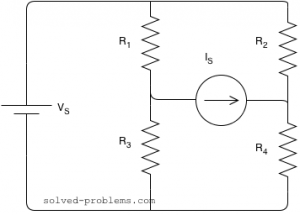
![]() ,
, ![]() ,
, ![]() ,
, ![]() ,
, ![]() ,
, ![]() .
.
Solution:
There are three meshes in the circuit. So, we need to assign three mesh currents. It is better to have all the mesh currents loop in the same direction (usually clockwise) to prevent errors when writing out the equations.
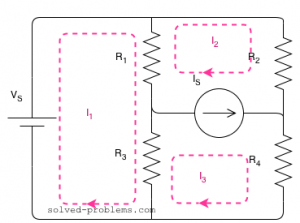
A mesh current is the current passing through elements which are not shared by other loops. This is to say that for example the current of the voltage source is ![]() , the current of
, the current of ![]() is
is ![]() and so on. But how about elements shared between two meshes? Current of such elements is the algebraic sum of both meshes. For example if we assume the current of
and so on. But how about elements shared between two meshes? Current of such elements is the algebraic sum of both meshes. For example if we assume the current of ![]() is defined with direction from top to bottom, its current would be
is defined with direction from top to bottom, its current would be ![]() . If one assume the inverse direction, i.e. from bottom to top, it would be
. If one assume the inverse direction, i.e. from bottom to top, it would be ![]() .
.
Now, lets write the equation for mesh of ![]() (Mesh I). A mesh equation is in fact a KVL equation using mesh currents. We start from a point and calculate algebraic sum of voltage drops around the loop:
(Mesh I). A mesh equation is in fact a KVL equation using mesh currents. We start from a point and calculate algebraic sum of voltage drops around the loop:
First the voltage source:
![]()
Now we have reached ![]() from its upper node. So its current is
from its upper node. So its current is ![]() and we have:
and we have:
![]()
One important point that you should remember and it always help you to validate the equation is that the current part for resistors is always equal to the current of the mesh that we are writing the equation for minus the current of the other mesh. Of course this is only valid if you respect the convention to
- define all the mesh currents in the same direction
- go around the loop at the same direction as the mesh current that you defined while writing the equation
Let’s continue writing the equation. The next element, which is also the last element, is ![]() . Without further thinking we can say that the term associated with this element is
. Without further thinking we can say that the term associated with this element is ![]() . (Why?)
. (Why?)
![]() .
.
The equation for Mesh I is done. The next mesh is Mesh II. But wait! what is the voltage across the current source to write in the mesh KVL equation? We don’t know. There are two ways to resolve this issue:
-
- Assign a voltage to the current source (
 ). Write equations using
). Write equations using  and later add equations of Mesh II and III to get rid of
and later add equations of Mesh II and III to get rid of  .
. -
- Write the equation for the Supermesh II & III.
A supermesh is a larger loop which has both meshes inside.
Let’s try both methods.
1) Using ![]()
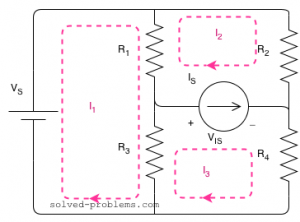
Mesh II:
![]()
Note that for ![]() , unlike the equation for Mesh I, the current is
, unlike the equation for Mesh I, the current is ![]() . This is because we are walking around the loop with the direction of
. This is because we are walking around the loop with the direction of ![]() , or briefly it is because we are writing the equation for mesh of
, or briefly it is because we are writing the equation for mesh of ![]() .
.
Mesh III:
![]() .
.
Let’s add two equations:
![]()
Simplifying:
![]()
2) Supermesh
Here is the supermesh:
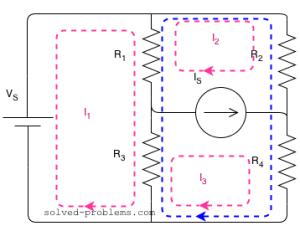
Around the loop clockwise:
![]() .
.
As you can see, we were able to write the equation in one shot. That is why the supermesh method is preferred.
Now, we have two equations: one for Mesh I and one for the supermesh. But there are three unknowns: ![]() ,
, ![]() and
and ![]() . So we need another equation. The third equation comes from the current source by writing KCL one of its nodes. We choose the node which is not shared by third loop which is the loop at the right hand side for this example. This way we minimize the number of terms in the equation. Note that the current of
. So we need another equation. The third equation comes from the current source by writing KCL one of its nodes. We choose the node which is not shared by third loop which is the loop at the right hand side for this example. This way we minimize the number of terms in the equation. Note that the current of ![]() and
and ![]() are
are ![]() and
and ![]() , respectively, but the terms for
, respectively, but the terms for ![]() and
and ![]() are more complicated because of
are more complicated because of ![]() involvement.
involvement.
Let’s apply KCL for the right hand side node. ![]() and
and ![]() are entering to the node and
are entering to the node and ![]() is leaving.
is leaving.
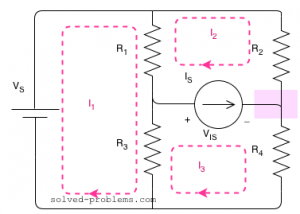
![]()
Now we have all three equations:

Let’s substitute values:
![]() ,
, ![]() ,
, ![]() ,
, ![]() ,
, ![]() ,
, ![]() .
.


4.9166

The circuit is solved. Any other voltage or current in the circuit can be easily found using mesh currents. To find power of sources, we need current of the voltage source and voltage across the current source.
For the voltage source, current is equal to ![]() as it is located at the unshared part of Mesh I. The current is entering from the negative terminal. Therefore, the active sign convention should be used to find the sign of power:
as it is located at the unshared part of Mesh I. The current is entering from the negative terminal. Therefore, the active sign convention should be used to find the sign of power:
![]() (supplying power).
(supplying power).
Take a look here if you are would like to know how power of independent sources should be calculated.
For the current source, the voltage is ![]() and can be calculated by KVL equation of mesh II:
and can be calculated by KVL equation of mesh II:
![]()
![]()
Here, the current is entering from the positive terminal. So, the passive sign convention should be used:
![]() (supplying power).
(supplying power).
Now, it is on you to find the power of all resistors and validate that the power conservation law is satisfied.
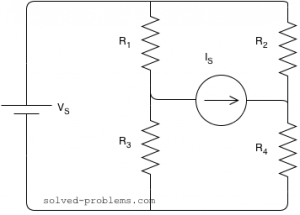
please send me electrical subjects solved problems about 1000 problems on each subject
If you ever get the questions please send me too.
How we will confirm the path of current in the loop or mesh ( Whether clock-wise or anti clock -wise)
We do not need to confirm it. We assume a path and after solving we get the numeric value which can be negative, which is fine.
yes me too i want more number of prblms to solve them
good examples, it really helps coming here. Can you please help me on diodes, bipolar junction transistors, digital electronics and analogue electronics, please:-)
Excellent
now i am able to understand the concep of mesh 😀 thanks sir it really helpful for me
its so well explained send some on diodes thanks
thank you sir…
IT IS INTERESTING WEBSITE
Now I’m able to understand super mesh analysis 😀tysm
Now I’m able to understand super mesh analysis 😀tysm
Well explained
This website was… how do you say it? Relevant!! Finally I’ve found something which helped me.
Thanks a lot!
I don’t understand why V(is) is positive in Mesh 3 while it is negative in Mesh 2. Shouldn’t the voltage drops across the loop equal the voltage source on the loop?
Nice Example
With the below circuit, mesh current method analysis can be known easily. In the circuit, loop currents I1 and I2 are applied in the clockwise direction
For solving the above circuit using mesh analysis, we have three unknown currents, and accordingly, we should form three equations and in addition apply the concept of supermesh analysis.